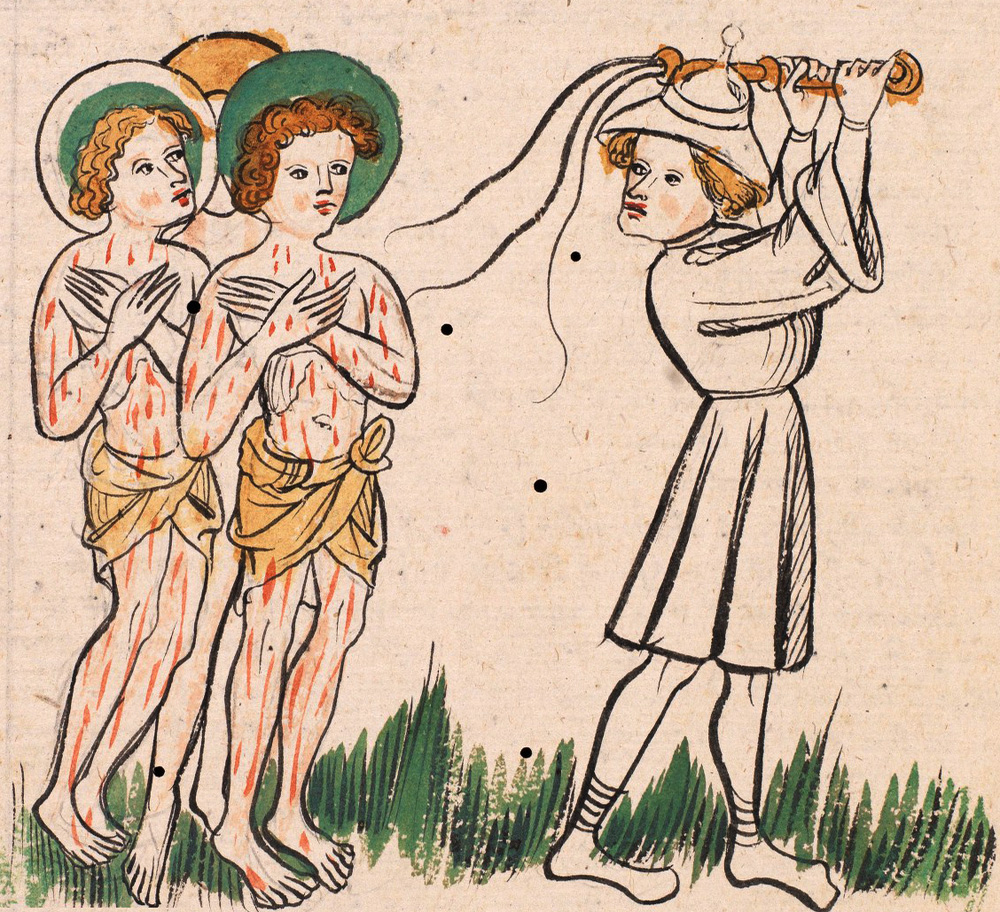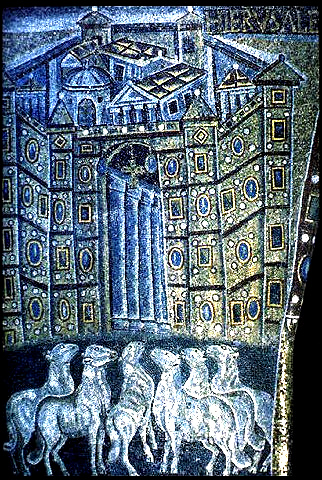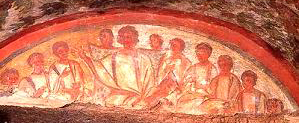By the time of this 6th-century mosaic there is some limited effort to individualize the apostles, but the main interest seems to be in carefully balancing the composition, with six apostles on each side (still in togas) and Christ in the middle (in this case seated on a globe representing the universe). We see a similar emphasis on balance, though quite differently realized, in this altar frontal from the 12th century in Catalonia or in the predella of this polyptych from the 15th century in Croatia.
Although one can expect to see exactly twelve persons in such assemblages, they will not always be the same twelve. At the cathedral at Cefalu, Sicily, for example, the twelve figures in the apse include only one of the two Jameses and omit Jude Thaddeus and Matthias. The three are replaced by Saints Mark, Luke, and Paul. Indeed, it is very common for Paul to be replace Matthias among the twelve figures, he and Peter often being the only ones with attributes.
Or the apostles may be represented as lambs, as in the picture at right and this mosaic in Santa Cecilia in Trastevere.
In the later Middle Ages the Virgin Mary may be the central figure with the apostles again arrayed in some balanced fashion with six on each side. One creative example of this is the arrangement of the apostles on both sides of the Assumption mosaic on the west façade of Orvieto's cathedral.
In the earliest Christian art there was a vogue for processions of saints bringing their crowns to the heavenly throne, an adaptation of the vision in Revelation 4:9-11. The most famous examples of these are the processions of martyrs along the left and right walls of the nave at Sant'Apollinare Nuovo in Ravenna. But there are also processions of apostles bringing their crowns to Christ. The Vatican Museums have a sarcophagus frontal with a central symbol of the resurrected Christ to which the apostles process from each side. Another fragment in the museum retains just four of the apostles, but it is clear that the original frontal also had all twelve processing to the same symbol or one very like it. The sarcophagi are from the 4th century, or possibly the early 5th. In the 6th-century mosaic mentioned above, some of the apostles bring crowns to the throne of Christ, while others bring books or scrolls. After that, we do not see much of this iconographic type.
In Matthew 19:28 Jesus tells the apostles, "when the Son of man shall sit on the seat of his majesty, you also shall sit on twelve seats judging the twelve tribes of Israel" (cf.Luke 22:30, Revelation 20:4). In St. Cecilia, Trastevere, a fresco shows them on their thrones.
In the earliest images and at all times in the East, the Apostles wear sandals with very thin straps (example), but in the medieval west they are pictured barefoot (as in the first picture at right). The sandals are consistent with Mark 6:9, where Jesus tells the Apostles to wear sandals on their mission and with the Greek text of Acts 12:8, where the angel tells the imprisoned Peter to put on his σανδαλια ("sandals").
On the other hand, picturing the Apostles barefoot would reflect Matthew 10:10 and Luke 10:4, where Jesus tells them NOT to wear calceamenta ("shoes" or "footwear") on their mission. For western artists, it would seem, the prohibition in Matthew and Luke is the better choice because it is more to the point spiritually. As Aquinas quotes in the Catena (II, 110):
When Matthew declares that shoes are not to be worn on the journey, he forbids anxiety about them, for the reason why men are anxious about carrying them, is that they may not be without them. This is also to be understood of the two coats [that Jesus also forbids at this time], that no man should be troubled about having only that with which he is clad, from anxiety lest he should need another, when he could always obtain one from the power given by the Lord (IV, 110).The earliest form of the Apostles' Creed goes back to the mid-second century and was probably "based upon an outline which dates back to the Apostolic age."1 In the 4th century Augustine said this creed had been composed by the Apostles themselves, its twelve articles corresponding to their number.2 Then in the early 5th century Rufinus of Aquileia cited a "tradition" that each Apostle contributed "his several sentence to one common summary."3 Taking their cue from Rufinus, medieval writers and artists assigned a specific phrase of the Creed to each Apostle. A sermon falsely attributed to Augustine appears to be the earliest text of this sort. It lists the Apostles in the order given in Acts 1:13, with St. Peter responsible for Credo in Deum, Patrem omnipotentem, St. John for creatorum caeli et terrae, and so on.4
In the art this practice took the form of image sequences in which each Apostle had a scroll bearing one clause from the Creed. Often these appear on predellas (example).5 A 16th-century convent in Mexico has a set of twelve santos inscribed with the twelve phrases. There is also a fresco in St. Paul Outside the Walls with six named Apostles holding scrolls with phrases that are now illegible. It is likely that the phrases are from the Creed and that there was once a second fresco with the other six. A 15th-century manuscript of de Valtan's Commentary on the Apostles' Creed in the British Library has twelve miniatures by Jean Poyet, each with one Apostle writing down one article of the Creed (Wieck, 35-36).
In the apse mosaic at St. Paul Outside the Walls the twelve again stand with scrolls, but in this case the phrases are from the "Gloria" hymn that is sung in the Mass.
Prepared in 2015 by Richard Stracke, Emeritus Professor of English, Augusta University.
HOME PAGE
An image in the Catacomb of Domatilla of Jesus teaching the apostles. See the description page.
OTHER IMAGES

In Acts 5:40 the Sanhedrin orders the apostles flogged. For this image of the episode, see the description page.

In the lower left of the apse at Santa Maria Maggiore, six lambs approach the gates of Jerusalem. The corresponding image on the lower right has six lambs at the gates of Bethlehem. These twelve most likely represent the Apostles. See the description page.
MORE IMAGES
- 6th century: Tondos of the twelve apostles, arranged by the order used in Matthew 10:1-4, line the inner face of the triumphal arch in the basilica of San Vitale, Ravenna.
- 13th century (est.): Stained Glass Windows in Regensburg Cathedral – The Apostles Window and Four Apostles.
- Early 14th century: Six of the more frequently pictured apostles are presented together in a strip right of the altar in the Bardi Chapel at Santa Maria Novella, Florence.
- 15th century: With the enthroned Christ on the back of the Pala d'Oro in St. Mark's, Venice.
- 1446: In this illuminated capital E Jesus predicts the martrydom of his apostles and their consequent reception into Heaven.
The Apostles: And the names of the twelve apostles are these: The first, Simon who is called Peter, and Andrew his brother, James the son of Zebedee, and John his brother, Philip and Bartholomew, Thomas and Matthew the publican, and James the son of Alpheus, and Thaddeus, Simon the Cananean, and Judas Iscariot, who also betrayed him. (Matthew 10:2-4)
Replacing Judas: [Peter said] "Of these men who have companied with us all the time that the Lord Jesus came in and went out among us, Beginning from the baptism of John, until the day wherein he was taken up from us, one of these must be made a witness with us of his resurrection." And they appointed two, Joseph, called Barsabas, who was surnamed Justus, and Matthias. And praying, they said: Thou, Lord, who knowest the hearts of all men, shew whether of these two thou hast chosen, To take the place of this ministry and apostleship, from which Judas hath by transgression fallen, that he might go to his own place. And they gave them lots, and the lot fell upon Matthias, and he was numbered with the eleven apostles. (Acts 1:21-26)
BIOGRAPHY
- The Fates of the Apostles, in Krapp, II, 51-54.
- Brief notes on the apostles' lives, names, and deaths in an 8th or 9th century text: "Incipit Breviarium Apostolorum ex Nomine vel Locis ubi Praedicaberunt, Orti vel Obiti Sunt," Analecta Bollandiana, volume II, 9-10.
ALSO SEE
NOTES
1 Catholic Encyclopedia, s.v. "Apostles' Creed."
2 Sermo de Symbolo, Migne, XL, 1189. Migne labels the sermon incertus. "uncertain." But Bühler (335) treats it as genuine.
3 Expositio in symbolum apostolorum
4 Migne, PL XXXIX, 2190. Bühler (335) says this seems to be the earliest text assigning specific phrases of the Creed to specific Apostles.
5 Other examples include the predella of the Coronation of the Virgin altarpiece by l'Alunno (Nicolò di Liberatore) in the Pinacoteca Vaticana and the Carlisle Cathedral screen described in Colledge (198). The cathedral in Zadar, Croatia, has ten statues of apostles which seem to be a set, but two of them differ slightly in appearance and carry scrolls with phrases from the Apostles' Creed, so they could be from a separate group. Petricioli, 76, attributes all ten to Matteo Moronzoni (sculptor) and Jean de Pierre de Milan (painter).
